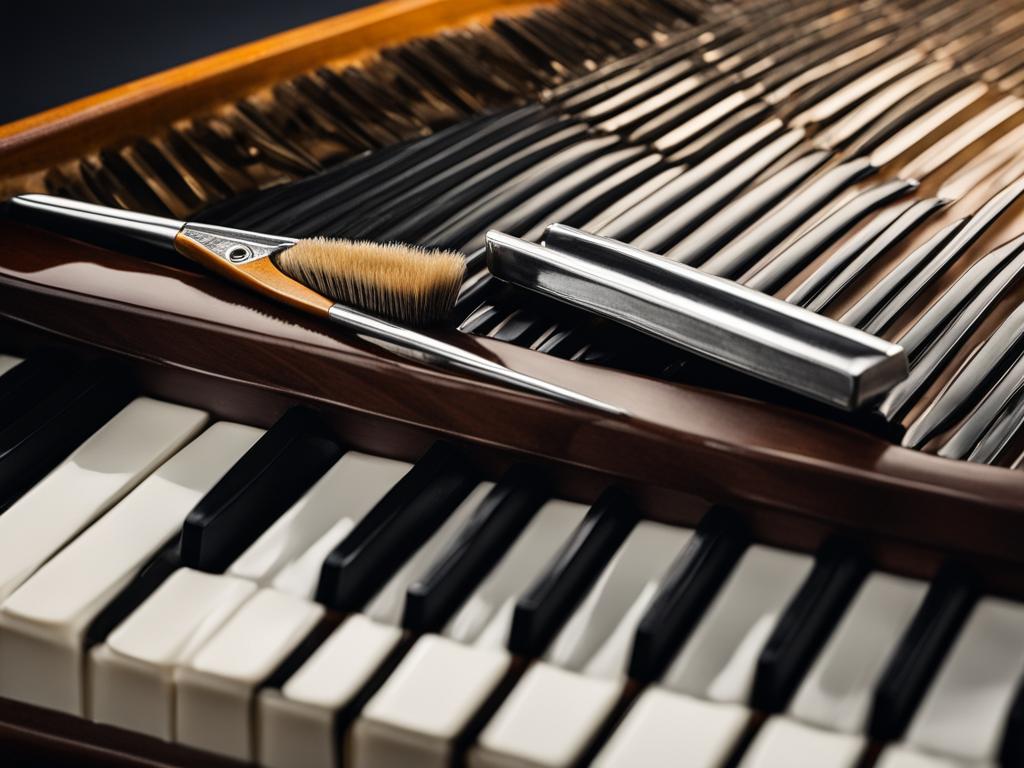Are you frustrated with sticky keys on your piano? Don’t worry – there are solutions you can try at home to fix the issue. Sticky keys can be caused by various factors, such as objects getting lodged underneath the keys or a build-up of moisture affecting key movement. By understanding the causes and implementing some do-it-yourself techniques, you can get your piano keys back to their smooth, responsive state.
Key Takeaways:
- Sticky piano keys can be caused by factors like objects under the keys, moisture, or changes in temperature and humidity.
- Try self-compacting the felt bushings, monitoring humidity levels, and cleaning or lubricating the rail pins to resolve sticking key issues.
- Regular maintenance practices like cleaning and lubricating the keys can help prevent sticky keys on a piano.
- For digital pianos, consult the product manual and follow the manufacturer’s troubleshooting instructions before attempting any repairs.
- If DIY solutions don’t work or if you prefer professional assistance, there are piano key repair services available.
Causes of Sticky Keys on a Piano
Sticking keys on a piano can be frustrating and hinder your playing experience. Understanding the causes of sticky keys can help you troubleshoot and resolve the issue. Here are some common factors that can lead to sticky keys:
- Changes in temperature and humidity: Fluctuations in temperature and humidity levels can cause the wood and felt components of the piano to expand or contract, resulting in keys that stick.
- Foreign objects: Accidentally dropping small objects like coins, paper clips, or debris into the piano can cause keys to become jammed or obstructed.
- Dirty rail pins: Over time, dust, dirt, and rust can accumulate on the rail pins that allow the keys to move smoothly. This build-up can impede the proper functioning of the keys.
- Key slip issues: The key slip, which is the front part of the keys, can sometimes get jammed against the white keys. This misalignment can cause keys to stick.
Identifying the specific cause of sticky keys is essential for effective repair. By addressing these underlying factors, you can restore the smooth and effortless movement of your piano keys.
“The key to resolving sticky keys is understanding the root cause and taking appropriate measures for repair.” – Piano Repair Specialist
To provide a clearer picture of the factors that contribute to sticky keys, refer to the following table:
| Cause | Description |
|---|---|
| Temperature and humidity changes | Fluctuations in temperature and humidity levels can cause the keys to expand or contract, resulting in sticking. |
| Foreign objects | Accidental introduction of objects like coins, paper clips, or debris into the piano can cause keys to become jammed or obstructed. |
| Dirty rail pins | Build-up of dust, dirt, and rust on the rail pins can impede smooth key movement and lead to sticking. |
| Key slip issues | Misalignment or jamming of the key slip against the white keys can cause keys to stick or have restricted movement. |
Being aware of these causes and the potential impact they can have on your piano’s performance will enable you to take appropriate steps to prevent and resolve sticky keys.
DIY Solutions for Sticky Piano Keys
Regular Maintenance
To keep your piano keys in optimal condition, regular maintenance is key. Cleaning the keys and lubricating them can help prevent and alleviate sticking issues. Here are some DIY solutions you can try at home:
- Clean the keys: Use a soft cloth dampened with a mild detergent solution to gently wipe the keys. Avoid using excessive moisture or harsh cleaning agents.
- Lubricate the keys: Apply a specialized piano key lubricant to reduce friction and improve key movement. Follow the manufacturer’s instructions for proper application.
Keep in mind that when performing these maintenance tasks, it’s important to be cautious and gentle, as pianos are delicate instruments.
You can download FREE E-Book the art of piano tuning
Self-Compact the Felt Bushings
If you encounter a sticky key, you can try self-compacting the felt bushings to improve key movement. Follow these steps:
- Depress and hold down the sticky key.
- Gently move the key from side to side to self-compact the felt bushings.
- Release the key and test its movement. Repeat the process if necessary.
This technique can help restore proper key function and alleviate sticking issues without the need for professional intervention.
Humidity Regulation
Humidity can greatly affect the performance of piano keys. To prevent sticking, consider the following:
- Monitor humidity levels: Use a hygrometer to measure the humidity in the room where your piano is located.
- Invest in a humidifier or piano heater-bar: Depending on the humidity levels, you may need to increase or decrease moisture in the air to maintain an optimal climate for your piano.
Regulating humidity can help prevent moisture-related issues that may cause sticking keys.
Professional Assistance
If the DIY solutions mentioned above do not resolve the sticky key issue or if you prefer professional assistance, it may be necessary to seek the help of a professional piano key repair service. They have the expertise and specialized tools to handle more complex repairs and ensure the long-term performance of your piano keys.

Note: Please refer to your manufacturer’s guidelines for specific cleaning instructions to avoid any potential damage to your keyboard.
Conclusion
Sticky keys on a piano can be a frustrating problem, but with the right knowledge and techniques, you can easily fix it at home. By identifying the causes of sticking keys, such as dirt, debris, or changes in humidity, you can take the necessary steps to prevent and resolve the issue.
If you prefer a professional touch, there are piano key repair services available that specialize in fixing sticky piano keys. These experts have the knowledge and experience to diagnose and resolve the problem efficiently, ensuring that your piano performs flawlessly.
Remember, regular maintenance is key to preventing sticky keys in the first place. By cleaning and lubricating the keys periodically, you can keep them in optimal condition. Additionally, monitoring the humidity levels of the room where your piano is located can help prevent moisture-related issues.
Take care of your piano, and it will reward you with beautiful music for years to come. Whether you choose to tackle the issue yourself or seek professional assistance, fixing sticky piano keys is a worthwhile endeavor that will enhance your playing experience.
FAQ
What causes sticking keys on a piano?
Sticking keys on a piano can be caused by factors like changes in temperature and humidity, objects falling and becoming lodged under the keys, or dirty rail pins.
How can I fix sticky keys on a piano?
To fix sticky keys on a piano, you can try depressing and gently moving the problematic key from side to side to self-compact the felt bushings. Cleaning objects and debris from the interior of the piano or lubricating and replacing rail pins can also resolve sticking key issues.
Can digital pianos experience sticky key issues?
Yes, digital pianos can also experience sticky key issues. Cleaning the keys with isopropyl alcohol or water and removing any debris or foreign objects from the keyboard can help alleviate the issue.
How can I clean sticky keyboard keys?
If you need to clean sticky keyboard keys, using rubbing alcohol is often the best solution. Disconnect the keyboard and use compressed air to remove debris and dust from between the keys. Wipe down the keyboard with isopropyl alcohol or a damp cloth.
What should I do if DIY solutions do not work for sticky piano keys?
If DIY solutions do not work or if you prefer professional assistance, there are piano key repair services available that can help resolve the issue.

